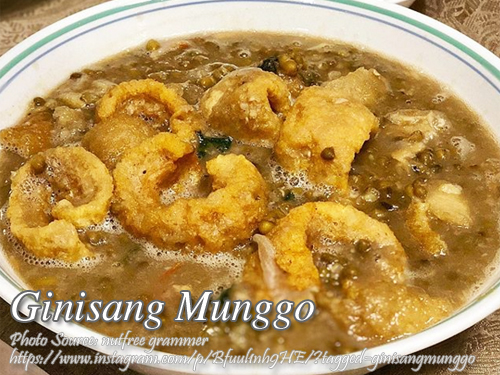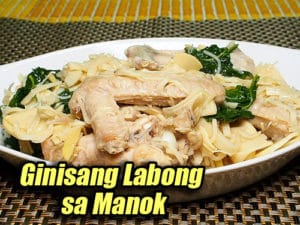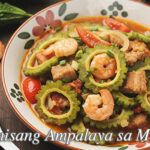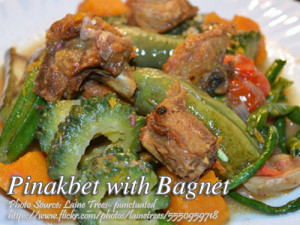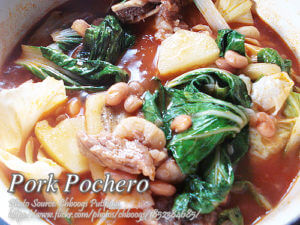I think this is one of the most budget friendly vegetable Filipino dish because munggo or mung beans are cheap and when cooked, it expands, like cooking a congee or lugaw. It also easy to cook this dish. Actually the name of the dish ginisang munggo, if you will take it literally, the dish should look like stir-fried. But when you see the finish product when cooking this dish, it looks like stewed mung beans.
Anyway there is still some stir frying of the ingredients in the procedure, stir-frying the pork and the aromatics before turning it into a mung beans stew. There are many variation of ginisang munggo, some version use tinapa fish flakes or fried fish flakes, alugbati and bitter gourd but my favorite version is this one, with lots of chicharon or pork cracklings and with the ampalaya leaves. You can also add some shrimps if you want to make it tastier. But I think using shrimp bouillon or dried shrimps will work just fine.
Ginisang Munggo: A Rainy Day Favorite From Lola’s Kitchen
If there’s one dish that reminds me of rainy Thursdays and the clatter of pots in my Lola’s old kitchen in Bulacan, it’s ginisang munggo. This humble dish—made with mung beans, a bit of pork, and whatever leafy greens are in season—may look simple on the surface, but it holds generations of comfort and thriftiness in every bowl.
Back when I was in high school, my cousin Kuya Ruel used to cook this every Friday. He said it was because “Munggo is pang-linis ng tiyan,” which I didn’t understand until later. It turns out, this dish is often served on Fridays in many Filipino homes due to religious practices around eating no meat that day. Ironically, his version always had a generous helping of crispy chicharon on top. That was his loophole.
Why Ginisang Munggo is a Staple in Filipino Kitchens
Mung bean stew is one of the most budget-friendly meals you can prepare. A small cup of munggo can easily feed a family of five once cooked—it swells and thickens like lugaw or arroz caldo. It’s the kind of dish that stretches both your peso and your patience, since it does take a bit of time to cook the beans until tender. But the reward is always worth it.
I remember my Tita Fe telling me, “Munggo tastes better the next day.” And she was right. Somehow, when the flavors sit overnight—the pork, the aromatics, the earthy beans—it all melds into something deeper and richer.
The Art of Sautéing: Why It Matters
The dish may be called ginisang munggo, which sounds like it’s just stir-fried mung beans, but what you actually get is more of a stew. Still, the initial sautéing process is crucial. You don’t want to skip this part.
Searing the pork first helps build flavor through browning, called the Maillard reaction. It brings out that savory, umami depth that plain boiling can’t achieve. Then you sauté garlic, onion, and tomatoes until everything’s fragrant and soft—this combo is the holy trinity of Filipino cooking, the base that builds the flavor foundation of so many beloved dishes.
Adding patis (fish sauce) at this stage, rather than at the end, lets it infuse the meat and aromatics more deeply. It’s that extra layer that separates a bland pot from a truly comforting one.
Choosing the Right Greens and Add-ins
Now, I know some people use malunggay leaves, while others swear by alugbati. But in our household, we always used ampalaya leaves. My older sister, Ate Glenda, swears it helps balance the richness of the pork and the savoriness of the stew. And besides, it’s what grows wild in the backyard most of the year.
If you’re new to this dish and worried about bitterness, don’t worry—ampalaya leaves are much milder than the fruit. They wilt beautifully in the broth and add just a hint of earthiness.
As for protein, feel free to use shrimp or even tinapa flakes if you like a smoky flavor. Personally, I keep it classic with pork belly and top it off with lots of crunchy pork cracklings. Don’t skip the chicharon—it adds texture and that satisfying salty crunch that takes this from simple to unforgettable.
How to Cook This Mung Bean Stew Like a Pro
Start by rinsing your mung beans thoroughly. Any grit or dust has to go. Boil them in water for about 45 minutes or until soft—you’ll know they’re ready when they start to break apart and the broth turns slightly thick.
In a separate pan, brown the pork in oil. Then sauté garlic, onion, and tomatoes until everything’s fragrant. Add the pork back in, splash in some fish sauce, and let it simmer a bit before adding your cooked munggo and its liquid.
Let it bubble gently, then stir in your greens and crushed chicharon. Cook for a few more minutes to let the flavors come together. Serve it hot over rice, and you’re good to go.
A Dish With Deep Roots
Some say mung beans arrived in the Philippines via Chinese traders centuries ago, which might explain why this legume shows up in both sweet and savory dishes across Asia. In the Philippines, it’s evolved into a uniquely comforting stew—nutrient-rich, adaptable, and deeply tied to our culinary identity.
To this day, whenever I cook a pot of ginisang munggo, the aroma takes me back to that rainy afternoon when I first tried my cousin’s version—extra chicharon, barely any greens, and full of warmth. It’s more than just food. It’s a memory on a plate.
So if you’re just starting out in the kitchen and looking for something hearty, affordable, and rich in tradition, give this munggo recipe a try. Trust me, it’s not just about feeding your stomach. It feeds the soul.
How to Cook Ginisang Munggo
Ingredients
- 250 grams dried mung beans (munggo)
- 250 grams pork belly slice into strips or minced
- 5 to 6 cups water
- 2 Tbsp. cooking oil
- 4 cloves garlic minced
- 1 pc medium onion sliced
- 2 pc medium tomatoes sliced
- 1 cup ampalaya leaves
- 2 Tbsp. fish sauce patis or to taste
- 150 grams pork cracklings chicharon
Instructions
How to cook Ginisang Munggo:
- Rinse the mung beans in running water. In a pot, put the mung beans and water. Bring to a boil and cook until the beans are tender. About 45 minutes.
- In a wok or deep pan, heat oil and stir fry the pork until brown. Set aside. Saute garlic and onion until fragrant. Then add the tomatoes and saute until soft. Mix the pork and add the patis and simmer for a few minutes.
- Add the cooked mung beans with the liquid and stir. Add the bitter melon leaves, pork chicharon and cook for at least 5 minutes more. Serve hot.
Notes
Cooking Tips:
Soak the Mung Beans for Faster Cooking
Soaking mung beans in water for at least an hour before boiling can significantly cut down the cooking time. This helps soften the beans quicker and results in a smoother, creamier texture. It’s a small step that saves time and gas—perfect for busy home cooks.Sauté Aromatics Until Fully Caramelized
Take your time sautéing the garlic, onions, and tomatoes until they're deeply golden and softened. This brings out their natural sweetness and adds depth to the flavor of the stew. Rushing this part will leave your dish tasting flat, so don’t skip the extra few minutes of browning.Add Greens and Chicharon Last
Ampalaya leaves and chicharon should be added during the final minutes of cooking to keep their texture and flavor intact. Overcooking the leaves makes them bitter, and chicharon will lose its crunch if left in too long. Stir them in, simmer briefly, then serve right away for the best results.
